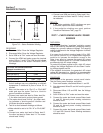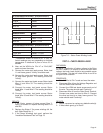
Section 7
DIAGNOSTIC TESTS
A. Schematic B. Pictorial
226 6
Figure 7-8. – Stator Excitation Winding
PROCEDURE:
1. Disconnect Wire 2 from the Voltage Regulator.
2. Disconnect Wire 6 from the Voltage Regulator.
3. Set a VOM to its “Rx1” scale and zero the meter.
4. Connect the VOM test leads across the terminal
ends of Wires 2 and 6. The VOM should indicate
the resistance of the Stator Excitation (DPE)
Windings.
EXCITATION “DPE” WINDING RESISTANCE *
(Measured Across Wires 2 & 6)
MODEL OHMS
RV45 (5410/5411) 2.59Ω
RV55 (5412/5413) 1.41Ω − 1.63Ω
RV65 (5414/5415) 1.59Ω − 1.84Ω
* Resistance values In ohms (Ω) at 20°C. (68°F.).
Actual readings may vary depending on ambient
temperature. A tolerance of plus or minus 5% is
allowed.
5. Now, set the meter to its “Rx1 K” or “Rx10,000”
scale and zero the meter. Test for a “short-to-
ground” condition as follows:
a. Connect one meter test lead to Stator lead No.
2, the other test lead to a clean frame ground.
b. The meter should read “Infinity”. Any other read-
ing indicates a “short-to-ground” condition and
the Stator should be replaced.
6. Test for a short between windings as follows:
a. Meter should be set to its “Rx1 K” or “Rx10,000”
scale.
b. Connect one meter test lead to Stator lead 2,
the other test lead to Stator lead 11. The meter
should read “Infinity”.
c. Connect one VOM test lead to Stator lead 2 the
other test lead to Stator lead 33. “Infinity” should
be indicated.
RESULTS:
1. If the Stator excitation (DPE) windings are open
or shorted, replace the Stator assembly.
2. If the excitation windings are good, perform
“Insulation Resistance Test”, page 13.
TEST 7 – CHECK SENSING LEADS / POWER
WINDINGS
DISCUSSION:
The Voltage Regulator “regulates” excitation current
flow to the Rotor by electronically comparing sensing
voltage to a pre-set reference voltage. The sensing
voltage is delivered to the Voltage Regulator via Wires
11S and 22S.
If an open circuit exists in sensing leads 11S or 22S,
the normal reaction of an unprotected Regulator
would be to increase the excitation current to the
Rotor in an effort to increase the actual AC output
voltage. This would result in a “full field” condition and
an extremely high AC output voltage.
To protect the system against such a high AC output
voltage, the Voltage Regulator will shut down if sens-
ing voltage signals are lost.
If the regulator shuts down, the generator’s AC output
voltage will decrease to a value that is commensurate
with the Rotor’s residual magnetism (about 5-12 VAC).
PROCEDURE:
Gain access to the generator control panel interior.
Test the Stator power windings, as follows:
1. From main breaker, disconnect Wires 11 and 33.
2. Also disconnect Wires 22 and 44 from the ground
terminal.
3. Disconnect Wires 11S and 22S from the Voltage
Regulator.
4. Set a VOM to its “Rx1” scale and zero the meter.
5. Connect the meter test leads across Stator leads
11 and 22. Normal power winding resistance
should be read.
6. Connect the meter test leads across Stator leads
33 and 44. Normal power winding resistance
should be read.
7. Connect the meter test leads across Stator leads
11S and 22S. Normal Power Winding resistance
should be read.
Page 40


















